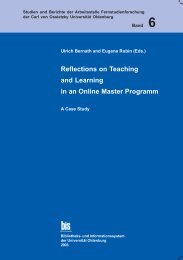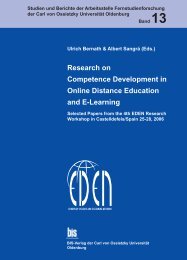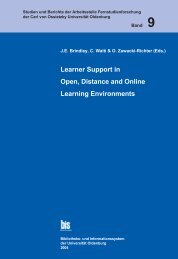Distance Education in Transition - Master of Distance Education ...
Distance Education in Transition - Master of Distance Education ...
Distance Education in Transition - Master of Distance Education ...
You also want an ePaper? Increase the reach of your titles
YUMPU automatically turns print PDFs into web optimized ePapers that Google loves.
A Pedagogical Model for Us<strong>in</strong>g Virtual Learn<strong>in</strong>g Spaces<br />
10. Virtual reality. Students can communicate <strong>in</strong>teractively with three-dimensional objects<br />
and persons <strong>in</strong> the three-dimensionally simulated spaces and landscapes <strong>of</strong> a virtual<br />
reality and even move <strong>in</strong> these spaces and observe. Through this immersion <strong>in</strong> virtual<br />
space the attention <strong>of</strong> the students can be drawn to given po<strong>in</strong>ts, <strong>in</strong>tensified and shielded<br />
from diversions from the real world. Their <strong>in</strong>teraction with a learn<strong>in</strong>g programme is more<br />
direct and more <strong>in</strong>tensive, because their actions are converted directly <strong>in</strong>to data, and the<br />
consequences <strong>of</strong> the actions are experienced directly <strong>in</strong> the three-dimensional learn<strong>in</strong>g<br />
space. Complex and abstract facts can be made more easily learnable through the senses.<br />
The habit <strong>of</strong> th<strong>in</strong>k<strong>in</strong>g <strong>in</strong> spaces can be satisfied <strong>in</strong> a particularly impressive manner here,<br />
<strong>in</strong> that special "knowledge spaces" and "<strong>in</strong>formation landscapes" are constructed<br />
(Alsdorf & Bannwart, 1997, p. 442). Many learners will f<strong>in</strong>d it advantageous above all if<br />
they are able to apply, try out and strengthen their knowledge and skills <strong>in</strong> these spaces<br />
<strong>in</strong> the same way as <strong>in</strong> the real world, e. g. pilot and tra<strong>in</strong> driver tra<strong>in</strong><strong>in</strong>g, or learn<strong>in</strong>g and<br />
practis<strong>in</strong>g operation techniques on the human body. Students have learn<strong>in</strong>g rooms<br />
available to them which only simulate emergencies, and so they tend not to be afraid <strong>of</strong><br />
the consequences <strong>of</strong> errors.<br />
We can see how the technological functions mentioned have an aff<strong>in</strong>ity with and lead to<br />
specific educational activities with which we have to come to terms with. If we wanted<br />
to summarise where the teach<strong>in</strong>g-learn<strong>in</strong>g situation <strong>in</strong> the digital learn<strong>in</strong>g environment<br />
deviates from traditional teach<strong>in</strong>g and learn<strong>in</strong>g, the follow<strong>in</strong>g six activity fields, which<br />
are not found <strong>in</strong> traditional learn<strong>in</strong>g, would be among the first mentioned:<br />
� The computer is used here as a universal teach<strong>in</strong>g and learn<strong>in</strong>g medium which<br />
basically conta<strong>in</strong>s all the media which have previously been used.<br />
� The computer enables students to compile files conta<strong>in</strong><strong>in</strong>g knowledge they have<br />
gathered themselves, and to return to these files aga<strong>in</strong> and aga<strong>in</strong>.<br />
� The computer mediates rapid access to distributed <strong>in</strong>formation where this is required<br />
for learn<strong>in</strong>g.<br />
� With suitable learn<strong>in</strong>g s<strong>of</strong>tware the computer can make <strong>in</strong>teraction with the learn<strong>in</strong>g<br />
program or learn<strong>in</strong>g s<strong>of</strong>tware <strong>in</strong>to a relevant and even to a dom<strong>in</strong>ant element <strong>of</strong> the<br />
learn<strong>in</strong>g process, if the learn<strong>in</strong>g situation requires it.<br />
� The computer enables and simplifies communication and collaboration with spatially<br />
distributed partners.<br />
� The computer also enables the simulation <strong>of</strong> dynamic models.<br />
� The computer enables and simplifies discover<strong>in</strong>g learn<strong>in</strong>g. Learners become the<br />
"designers and co-authors <strong>of</strong> their education" (Kle<strong>in</strong>schroth, 1996, p. 173).<br />
These functions are not, however, structurally l<strong>in</strong>ked to one another as <strong>in</strong> real learn<strong>in</strong>g<br />
spaces, but are available separately, on request. To rema<strong>in</strong> with this metaphor: digital<br />
learn<strong>in</strong>g spaces are not l<strong>in</strong>ked together <strong>in</strong> a virtual school or university build<strong>in</strong>g, but<br />
exist somewhere <strong>in</strong> a virtual learn<strong>in</strong>g cosmos.<br />
If the possibilities for us<strong>in</strong>g the technological advances have been recognised, tried out<br />
and <strong>in</strong>tegrated <strong>in</strong> the arsenal <strong>of</strong> learn<strong>in</strong>g processes available for <strong>in</strong>structional design, the<br />
misuse <strong>of</strong> computerised communication for present<strong>in</strong>g traditional lectures ("talk<strong>in</strong>g<br />
heads"), for hold<strong>in</strong>g conventional lessons with dom<strong>in</strong>eer<strong>in</strong>g teachers, or with hold<strong>in</strong>g<br />
traditional sem<strong>in</strong>ars with papers be<strong>in</strong>g read and films be<strong>in</strong>g shown, is not merely seen as<br />
89





